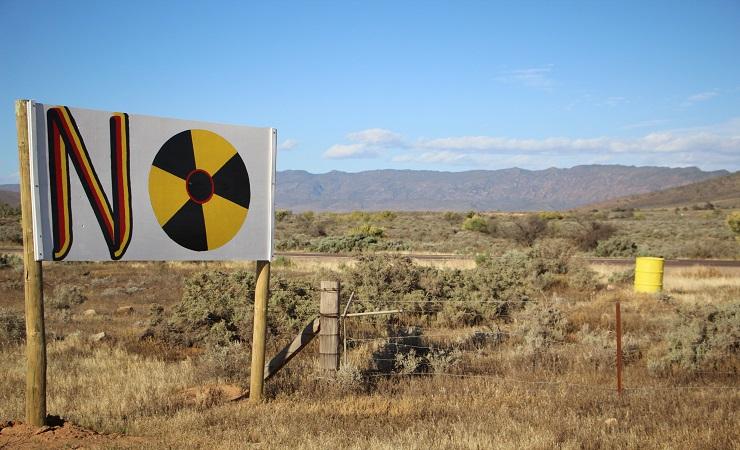ASIACALLING
Australian Aboriginal community fight proposed nuclear waste site
"The Australian government has long been trying to find a place to store nuclear waste. A proposed storage facility in remote Australia has divided locals, with Aboriginal elders vowing to fight it."
Jarni Blakkarly

The Australian government has long been trying to find a place to store the country’s low and intermediate level nuclear waste, which is mostly generated for nuclear medicine and radiotherapy.
However a proposal for a storage facility in the remote Australian outback has divided the nearby small town, with the local Aboriginal community opposing the plan and promising to fight it.
Reporter Jarni Blakkarly travelled to the remote South Australian town of Hawker, in the Flinders Rangers to find out why.
Transcript -
The Flinders’ Rangers is named after the British explorer who travelled across these remote mountains in the early 19th century.
But Regina McKenzie’s ancestors walked this land for tens of thousands of years before that.
“That hill over there, that’s the law giver. Every hill is part of our accessorial story. Our mura is our past, present and future,” explains Regina.
Today Regina and her sister Heather are taking me out to a sacred watering hole, an ancient oasis in the thousands of miles of dry landscape in all directions.
It’s just a few hundred meters away from where the federal government has proposed to build a nuclear waste storage facility.
![]()
All around Australia, low-level intermediate level nuclear waste, generated from medical radiotherapy and other experiments is stored at hospitals and other sites.
For decades the government has been looking to build one central place to store all the nuclear waste, but previous efforts have failed largely due to community opposition.
Grant Chapman describes the latest site that has been identified, “it’s about 25,000 hectares which in station terms for that country means it is a relatively small property and currently it is used for cattle grazing.”
Chapman lives in the South-Australian capital of Adelaide and last year when the government asked for property owners to nominate their land for a storage facility, he offered his property near Hawker.
The nuclear waste would be stored on his land, but the surrounding land is owned by the Indigenous land cooperative, where Regina and others live.
Chapman is a former senator and says his role on a committee looking into nuclear storage was why he volunteered his property.
“We reached a conclusion there should be a centralised, properly engineered storage facility for low-level radio-active waste in Australia. That was the best and safest way to deal with it, rather than have it lying around in universities and hospital and industrial sites not being properly cared for.”
One of the reasons this site was selected was because the government said there was a high-level of community support for the proposal.
![]()
But the community is divided. Some support the proposal, and others are strongly against it.
Some residents are concerned about the how safe the nuclear storage facility will be, given the area is prone to flash-flooding and minor earthquakes.
And there is also some distrust of the government, fearing that once the initial nuclear storage facility is there, it will be expanded in the future.
Hawker is a small town of a population of just 250 people and it’s declining. Farming and tourism are the two remaining businesses since other nearby industries have closed.
Ian Carpenter is the vice-chair of the Hawker development board and says the nuclear facility will bring about 15 jobs, which can help secure the town’s future.
“People are just moving away, there isn’t much here for younger people,” he said.
“If we go back 18 years ago this town had 28 business in the town, today we are down to 6, so what are we going to be in another 18 years? This could be good for our area,” claimed Carpenter.
![]()
No one knows if the proposal will go ahead at this stage. At the moment the government is doing further studies on the geology of the area and community consultations, and it’s expected a final decision will be made in the next 12 months.
Back at the stream with Regina and her sister, she tells me this is a special healing place for women.
Even though the government says a large part of the economic development from the plan would benefit the Indigenous community, Regina believes that protecting their culture and heritage from damage is far more important.
“In our culture we have to keep a balance in everything and putting a waste dump here puts it out of balance,” Regina told me.
“This is where we get our stories from, this land, it’s our inheritance. I believe my people, the Adnyamathahna people we paid a big price, we were almost pushed to extinction, when we were colonised.”
Regina continued, “I believe what we have left, we have the right to say no, you are not destroying any more of us, when they destroy the land they destroy us.”
![]()
- Jarni Blakkarly
- Australia nuclear waste
- nuclear
- Regina McKenzie
- Hawker South Australia
- Adnyamathahna
Komentar (0)
KBR percaya pembaca situs ini adalah orang-orang yang cerdas dan terpelajar. Karena itu mari kita gunakan kata-kata yang santun di dalam kolom komentar ini. Kalimat yang sopan, menjauhi prasangka SARA (suku, agama, ras dan antargolongan), pasti akan lebih didengar. Yuk, kita praktikkan!